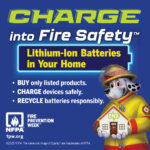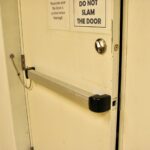This is the 6th post in a series about fire doors and the results of a recent (unscientific) survey.
For anyone who is just tuning in or has lost track of this series of posts, I conducted a survey about what the general public knows about fire doors and I learned 2 things – 1) John Q. Public doesn’t know much about fire doors, and 2) John Q. Public WANTS to know about fire doors! Of course, I’m generalizing, but seriously, many of the survey respondents asked for more information or had questions or concerns about the fire doors around them. So I started this series of posts as a way for JQP to learn a bit about fire doors.
So far I’ve posted about two major rules of fire doors – they must be SELF-CLOSING, and SELF-LATCHING. In my opinion, if we could fix all of the fire doors that are propped open, have broken closers, or don’t latch, we’d greatly improve the safety of our buildings. Fire doors can’t protect us if they’re held open with a wood wedge or the latchset has been removed.
There are MANY other rules about fire doors, so I could go on and on for weeks about glazing, gasketing, clearances, labels, etc., but I think this might be more than JQP can take. On the other hand, this is really important information for all of the door-people and code officials who read this blog.
That’s why I started a new site that’s all about fire doors and fire door inspection. WOOHOO! 😉 It’s still a work in progress, but you’re welcome to check it out, learn about some of the other “rules,” and give me feedback about what else should be added. TA-DA!: www.firedoorguide.com
But before you go, there’s something I REALLY want you to see. I stumbled across this video of two doors being fire tested – one manufactured correctly and one with incorrect intumescents around the perimeter of the door and the glazing. I’m not sure most of us realize how important these little details can be. We’ve grown so accustomed to seeing non-compliant fire doors that the alarm bells don’t ring as loudly as they should.
If you’ve got 3 minutes and 42 seconds, watch how these two doors perform. Which door would you rather have protecting you or your family members – the door that was manufactured correctly, or the one with a seemingly minor flaw?
You need to login or register to bookmark/favorite this content.





In the video, the test is by Chiltern to BS standards which is entirely different that how a door is tested by UL to NFPA / ANSI standards. The mandatory Self closing and self latching under North American codes, is an ‘either/or’ under the British Standard. Besides they do not have the hose stream test.
They have been using Intumenscent seal on doors since decades to offset ‘self latching’ at elevated temperature. While we in USA made adopted intumescent only after the positive pressure test became mandatory, but retained the self closing + self latching criteria.
I am not a fan of BS standards and their test methods, especially for fire doors.
I’m not advocating one test over another, but I think that these two doors tested side-by-side are a good illustration of the value of using the correct intumescent when it is required.